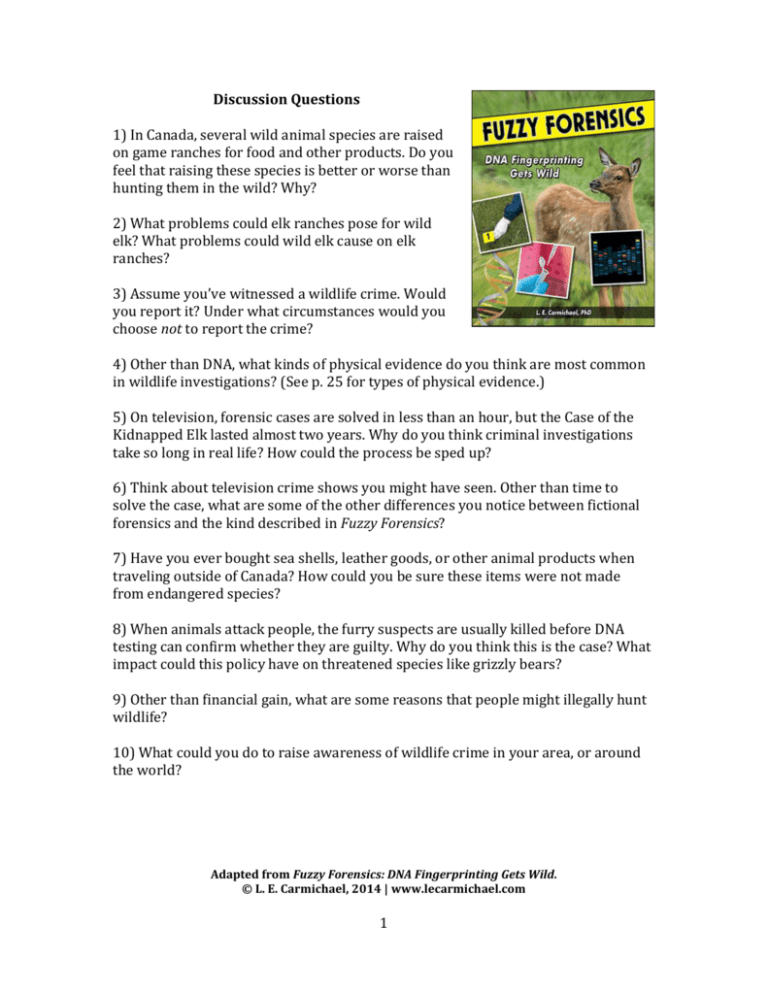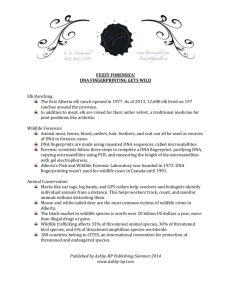Questions and Activities
advertisement

Discussion Questions 1) In Canada, several wild animal species are raised on game ranches for food and other products. Do you feel that raising these species is better or worse than hunting them in the wild? Why? 2) What problems could elk ranches pose for wild elk? What problems could wild elk cause on elk ranches? 3) Assume you’ve witnessed a wildlife crime. Would you report it? Under what circumstances would you choose not to report the crime? 4) Other than DNA, what kinds of physical evidence do you think are most common in wildlife investigations? (See p. 25 for types of physical evidence.) 5) On television, forensic cases are solved in less than an hour, but the Case of the Kidnapped Elk lasted almost two years. Why do you think criminal investigations take so long in real life? How could the process be sped up? 6) Think about television crime shows you might have seen. Other than time to solve the case, what are some of the other differences you notice between fictional forensics and the kind described in Fuzzy Forensics? 7) Have you ever bought sea shells, leather goods, or other animal products when traveling outside of Canada? How could you be sure these items were not made from endangered species? 8) When animals attack people, the furry suspects are usually killed before DNA testing can confirm whether they are guilty. Why do you think this is the case? What impact could this policy have on threatened species like grizzly bears? 9) Other than financial gain, what are some reasons that people might illegally hunt wildlife? 10) What could you do to raise awareness of wildlife crime in your area, or around the world? Adapted from Fuzzy Forensics: DNA Fingerprinting Gets Wild. © L. E. Carmichael, 2014 | www.lecarmichael.com 1 Activities 1) Many of the laws that govern game ranches were designed to protect wildlife. Some game ranchers, however, believe that these laws are too strict and place unnecessary pressure on their businesses. Research the ranchers’ side of this story. How does it compare to the viewpoint explored in Fuzzy Forensics? 2) Use the Genes in a Jar experiment (p. 32-33) to purify animal DNA. Rub a Q-tip inside your mouth (or a pet’s mouth!) to collect skin cells. Swirl the Q-tip in hot water for a few minutes. Then follow steps 2-5. How much DNA do you see? Do some research to find out why this experiment works best with plant DNA. 3) Choose one of your favourite birds, animals, or fish. Visit www.iucnredlist.org to learn about threats to that species. Then visit www.cites.org to find out whether your species is protected under CITES. 4) Collect hairs from different domestic species, like dogs, cats, rabbits, or horses. Can you tell the difference between each type of hair under a microscope? How do the hairs compare to one of yours? 5) DNA fingerprinting is not always accepted as evidence in court. Find out why this is sometimes the case. How could DNA evidence become a more effective tool for wildlife investigations? Adapted from Fuzzy Forensics: DNA Fingerprinting Gets Wild. © L. E. Carmichael, 2014 | www.lecarmichael.com 2






